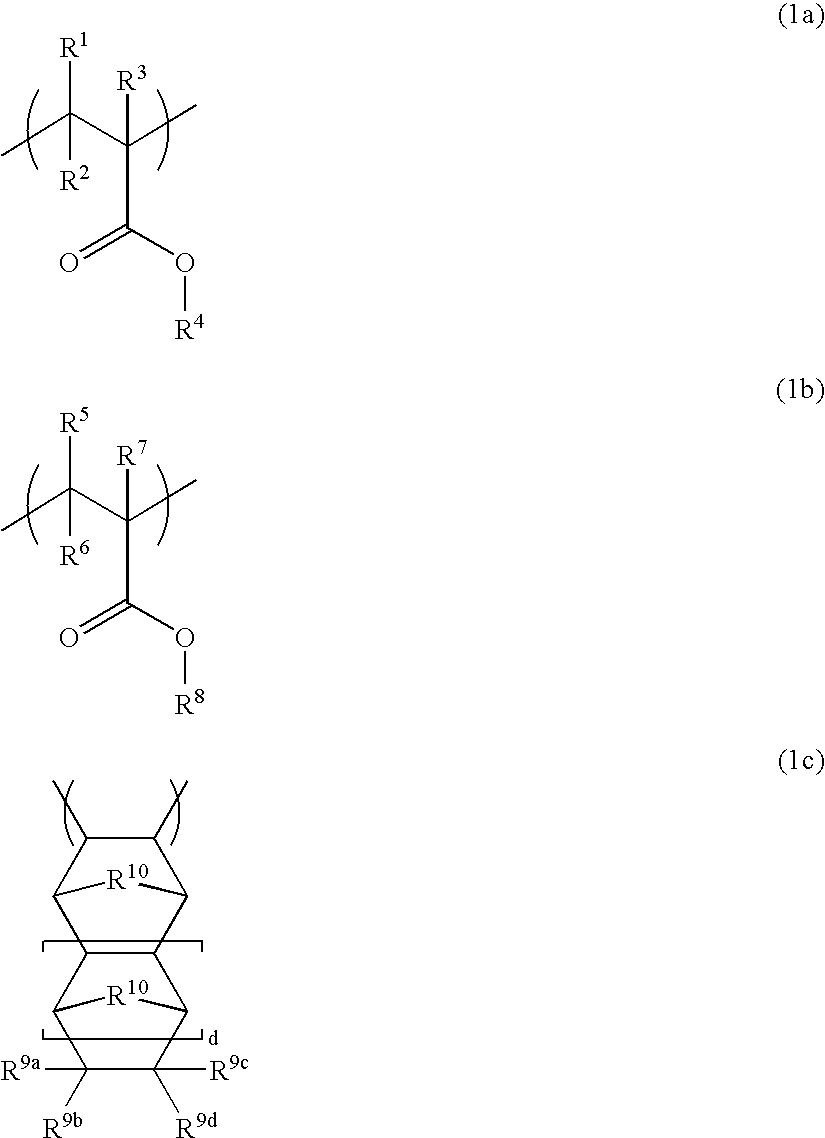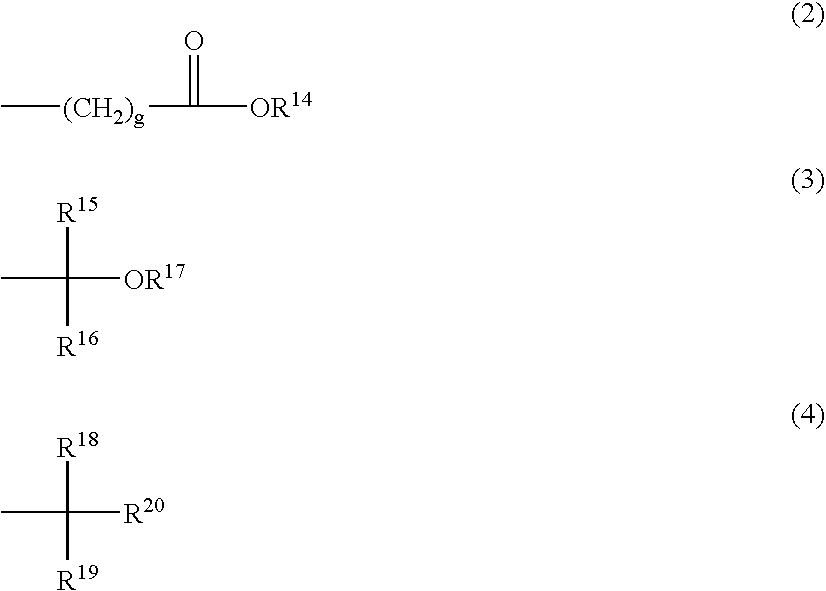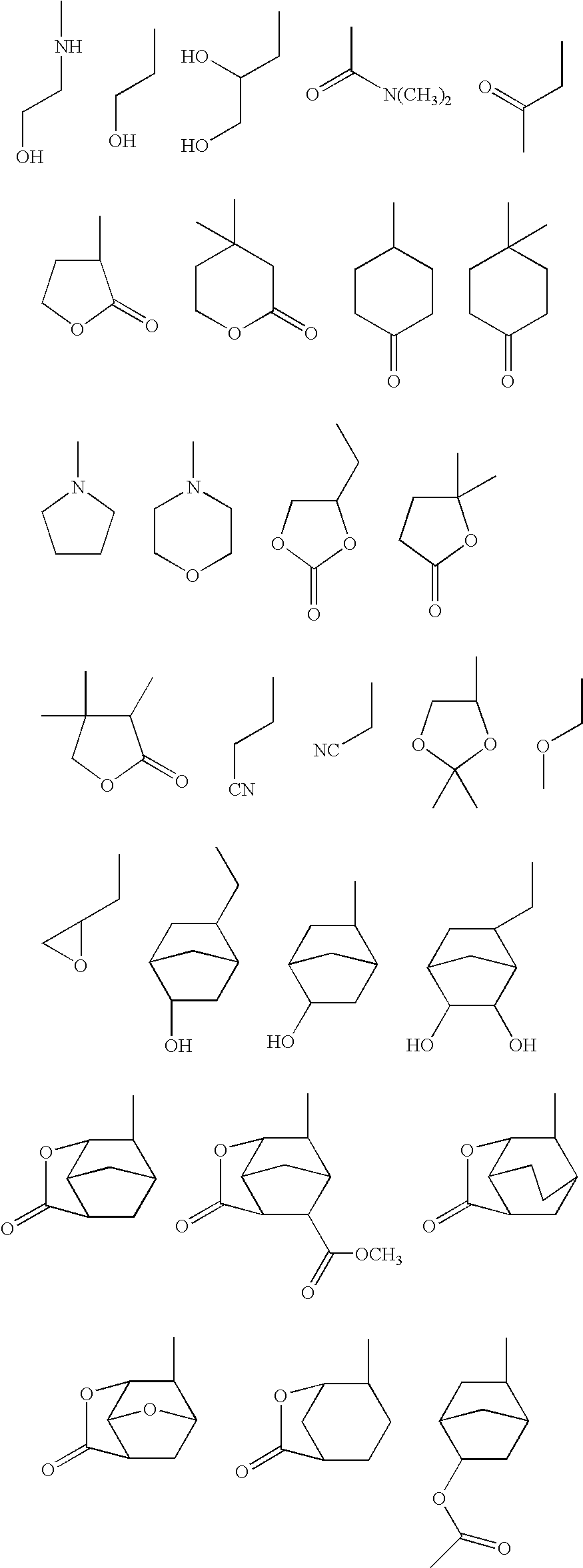Polymer, resist composition, and patterning process
a composition and resist technology, applied in the direction of auxillary/base layers of photosensitive materials, instruments, photosensitive materials, etc., can solve the problems of weak etching resistance of arf resists, rough surface after etching, and difficult to achieve etching, and achieve the effect of improving resist composition transparency, high sensitivity, and fully resisting plasma etching
- Summary
- Abstract
- Description
- Claims
- Application Information
AI Technical Summary
Benefits of technology
Problems solved by technology
Method used
Image
Examples
synthesis example 1
Copolymerization of Monomers 1, 2 and 3
[0389]In a 500-ml flask, 19.6 g of Monomer 1, 28.9 g of Monomer 2, and 19.6 g of Monomer 3, all shown below, were dissolved in 100 ml of toluene. The system was fully purged of oxygen, charged with 0.38 g of the initiator AIBN, and heated at 60° C. at which polymerization reaction took place for 24 hours.
[0390]
[0391]The polymer thus obtained was worked up by pouring the reaction mixture into hexane whereupon the polymer precipitated. The polymer collected was dissolved in tetrahydrofuran and poured into 2 liters of hexane for precipitation. This cycle was repeated twice. The polymer was isolated and dried. There was obtained 47.6 g of a white polymer, which was found to have a Mw of 8,800 as measured by GPC, and a dispersity (Mw / Mn) of 1.4 as determined from the GPC elution curve. On 1H-NMR analysis, the polymer was found to consist of Monomer 1, Monomer 2 and Monomer 3 in a molar ratio of 41:26:33.
synthesis example 2
Copolymerization of Monomers 1, 2 and 4
[0392]In a 500-ml flask, 19.6 g of Monomer 1, 28.9 g of Monomer 2, and 24.1 g of Monomer 4, all shown below, were dissolved in 100 ml of toluene. The system was fully purged of oxygen, charged with 0.38 g of the initiator AIBN, and heated at 60° C. at which polymerization reaction took place for 24 hours.
[0393]
[0394]The polymer thus obtained was worked up by pouring the reaction mixture into hexane whereupon the polymer precipitated. The polymer collected was dissolved in tetrahydrofuran and poured into 2 liters of hexane for precipitation. This cycle was repeated twice. The polymer was isolated and dried. There was obtained 53.7 g of a white polymer, which was found to have a Mw of 10,600 as measured by GPC, and a dispersity (Mw / Mn) of 1.65 as determined from the GPC elution curve. On 1H-NMR analysis, the polymer was found to consist of Monomer 1, Monomer 2 and Monomer 4 in a molar ratio of 40:22:38.
synthesis example 3
Copolymerization of Monomers 1, 5 and 6
[0395]In a 500-ml flask, 19.6 g of Monomer 1, 27.3 g of Monomer 5, and 19.8 g of Monomer 6, all shown below, were dissolved in 100 ml of toluene. The system was fully purged of oxygen, charged with 0.38 g of the initiator AIBN, and heated at 60° C. at which polymerization reaction took place for 24 hours.
[0396]
[0397]The polymer thus obtained was worked up by pouring the reaction mixture into hexane whereupon the polymer precipitated. The polymer collected was dissolved in tetrahydrofuran and poured into 2 liters of hexane for precipitation. This cycle was repeated twice. The polymer was isolated and dried. There was obtained 48.0 g of a white polymer, which was found to have a Mw of 9,900 as measured by GPC, and a dispersity (Mw / Mn) of 1.58 as determined from the GPC elution curve. On 1H-NMR analysis, the polymer was found to consist of Monomer 1, Monomer 5 and Monomer 6 in a molar ratio of 40:28:32.
PUM
| Property | Measurement | Unit |
|---|---|---|
| wavelength | aaaaa | aaaaa |
| wavelengths | aaaaa | aaaaa |
| boiling point | aaaaa | aaaaa |
Abstract
Description
Claims
Application Information
 Login to View More
Login to View More - R&D
- Intellectual Property
- Life Sciences
- Materials
- Tech Scout
- Unparalleled Data Quality
- Higher Quality Content
- 60% Fewer Hallucinations
Browse by: Latest US Patents, China's latest patents, Technical Efficacy Thesaurus, Application Domain, Technology Topic, Popular Technical Reports.
© 2025 PatSnap. All rights reserved.Legal|Privacy policy|Modern Slavery Act Transparency Statement|Sitemap|About US| Contact US: help@patsnap.com



